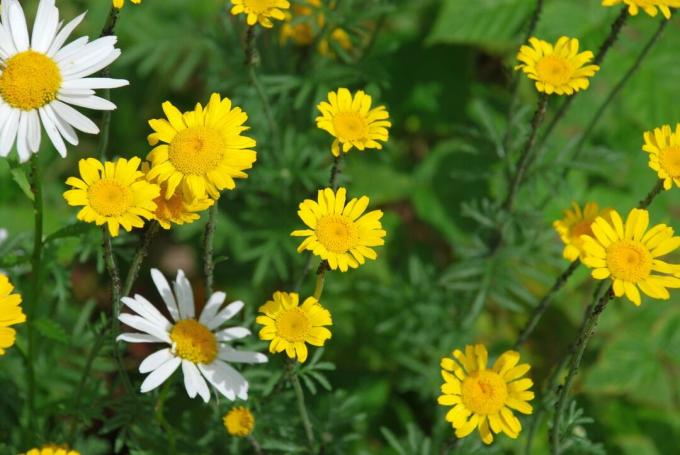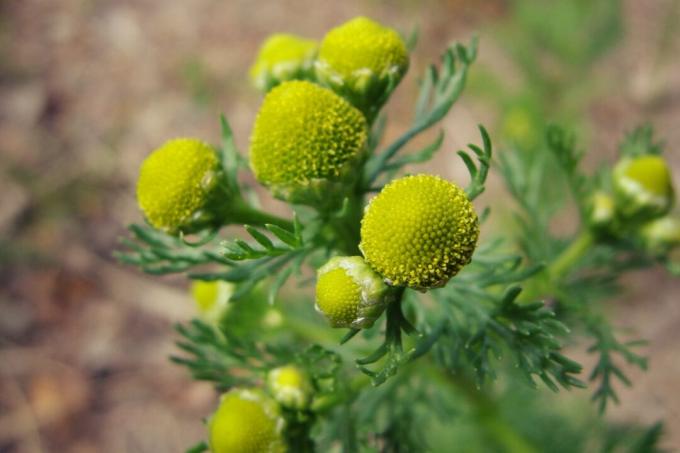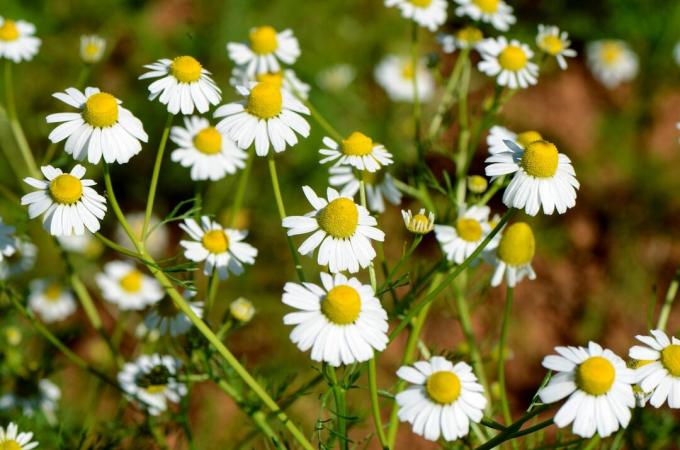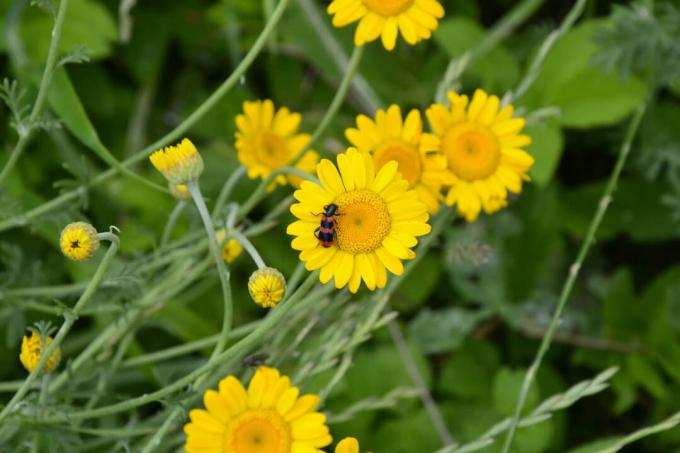Chamomile varieties differ in the composition of their ingredients. But there is also a risk of confusion with poisonous chamomile species.

With the chamomile species and varieties it is not so easy. There are some plant species that have the German name chamomile, but belong to a different plant genus than the Real chamomile (Matricaria chamomilla). Some, however, have similar ingredients and are also used in medicine.
contents
-
Chamomile types and varieties
- Real chamomile
- Radiant chamomile
- Roman chamomile
- Odorless chamomile
- dog chamomile
- dyer's chamomile
- Confusion of real chamomile: distinguish between similar plants
Chamomile types and varieties
The genus of camomiles (Matricaria) counts about 25 species, two of which are native to us, namely the real chamomile and the radiant chamomile (Matricaria discoidea). The closely related genus of sea chamomile (Tripleurospermum) consists of about 40 species, two of which occur naturally in Germany. This is the rare coastal sea chamomile (
Tripleurospermum maritimum) and the scentless sea chamomile (Tripleurospermum inodorum). There are also other chamomile species from other genera that look very similar to real chamomile and offer a wide range of uses.
Real chamomile
The true chamomile (Matricaria chamomilla) is known almost everywhere, not least because of the coveted chamomile tea. For this reason it is cultivated commercially, but it can also still be found growing wild in Germany. At the real chamomile breeding work is also carried out. The aim is to vary the composition of the valuable ingredients. But a uniform growth is also pursued as a breeding goal for the commercial cultivation of chamomile. Examples of important types are:
- 'Bode Gold': Aromatic and large-flowered variety
- 'Gosal': Chamomile oil contains a lot of bisabolol
- 'Zloty Lan': The essential oil contains a high proportion of the blue coloring chamazulan
When harvesting camomile by the wayside or in fields and meadows, there is not only a risk of confusion with less effective doubles, but also with poisonous types of chamomile such as dog chamomile (anthemis). It is therefore important to know the concise characteristics of the popular medicinal herb:
- Round, bulging base with many yellow tubular flowers.
- If you cut the flowers in half through a cross-section, the bottom of the flower is hollow on the inside.
- The real chamomile reaches a size of up to 50 cm.
- All parts of the plant have a distinct chamomile smell when rubbed in the hands.

Radiant chamomile
The Radiant Chamomile (Matricaria discoidea) belongs to the same genus as real chamomile. It stands out because it has no white ray florets, but the flower head consists only of the yellow tubular florets in the middle. The lack of ray florets serves as an obvious but very important distinguishing feature between true chamomile and rayless chamomile. Both have in common the hollow base and the intense scent of camomile. In terms of ingredients, however, the radiant chamomile is less well equipped than the real chamomile. You can use it as a medicinal plant in a similar way, but the effect is less pronounced.

Roman chamomile
the Roman chamomile (Chamaemelum nobile) belongs to a different genus, but resembles the real chamomile almost completely in appearance and effect. Unlike chamomile, however, it is a perennial herb. With a size of 15 to 30 cm, it is much smaller than the related medicinal herb, but is in no way inferior to it in its beneficial effect due to the similar ingredients it contains. Another distinguishing feature are the leaves, which appear somewhat finer pinnate in Roman chamomile. In addition, the bottom of the head is filled with pith when cut open and not hollow like in real chamomile.

Odorless chamomile
The odorless chamomile (Tripleurospermum inodorum) belongs to the genus of beach camomiles (Tripleurospermum). It is common throughout Germany. The odorless chamomile not only lacks the characteristic chamomile scent, as the name suggests. It also contains no ingredients that could be used for healing purposes. Externally, however, it looks very similar to real chamomile. As is so often the case, a sure distinguishing feature is the pithy bottom of the cup, which is hollow in real chamomile. This can be recognized by a cross section through the daisy flower.

dog chamomile
Also the dog chamomiles (anthemis) form a separate genus. These include around 160 different species, four of which occur in Central Europe. Dog chamomiles sometimes only give off a faint chamomile scent or even smell unpleasant. They are therefore also known as false or fake chamomile. Some types are also used for medicinal purposes, others have no effect or can cause skin irritation or allergic reactions. Apart from the dyer's dog chamomile listed below, there are also the following types in Germany:
- Russian dog chamomile (Anthemis ruthenica): A species not native to Germany but introduced to Germany with shaggy leaves.
- Austrian dog chamomile (Anthemis austriaca): Leaves felty hairy on the underside.
- Stinking dog chamomile (Anthemis cotula): Emits an unpleasant odor and may irritate mucous membranes when ingested as a tea.
- field dog chamomile (Anthemis arvensis): This species smells only faintly of chamomile and is sometimes used in medicine.

At a glance: Difference between dog chamomile and real chamomile
- The base of the flower head is hollow in chamomile, pithy in dog chamomile
- Leaves of real chamomile hairless, dog chamomile hairy
- Real chamomile with a typical scent, dog chamomile has a rather unpleasant or faint smell
dyer's chamomile
There is also no risk of confusion with the dyer's chamomile (Anthemis tinctoria), which is also called dyer's dog chamomile. Their flowers are completely yellow - that is, the ray florets on the edge are also yellow. People have already taken advantage of the beautiful color of this yellow chamomile. The dyer's chamomile is used to dye wool and fabrics, which then shine in a wide variety of yellow tones.

Confusion of real chamomile: distinguish between similar plants
At first glance, real chamomile has a number of doubles. However, it only shares the strong scent of chamomile and the typical appearance with the white-yellow basket flowers with Roman chamomile, which is in no way inferior to it in terms of effectiveness. A reliable feature by which you can recognize the real chamomile is the hollow bottom of the cup. This is otherwise only found in non-radiant chamomile, which, however, can be distinguished from true chamomile at first glance. So it is best to always have a knife at hand when collecting chamomile in nature. Real chamomile can be clearly identified by a cross section through the flower. Plants that could be confused with real chamomile are:
- Roman chamomile (pithy cup bottom)
- dog chamomiles (pithy cup bottom)
- Odorless chamomile (pithy cup bottom)
- Radiant chamomile (missing white ray florets)

Now you are prepared for the harvest of chamomile, so that no less effective or poisonous relative of real chamomile should end up in the tea bag the next time you have a cold. You may even knowingly deal with the similarly effective Roman chamomile in the future.
The possible uses of chamomile seem endless. In our special article we have everything you need to know about the Ingredients and uses of chamomile summarized.
